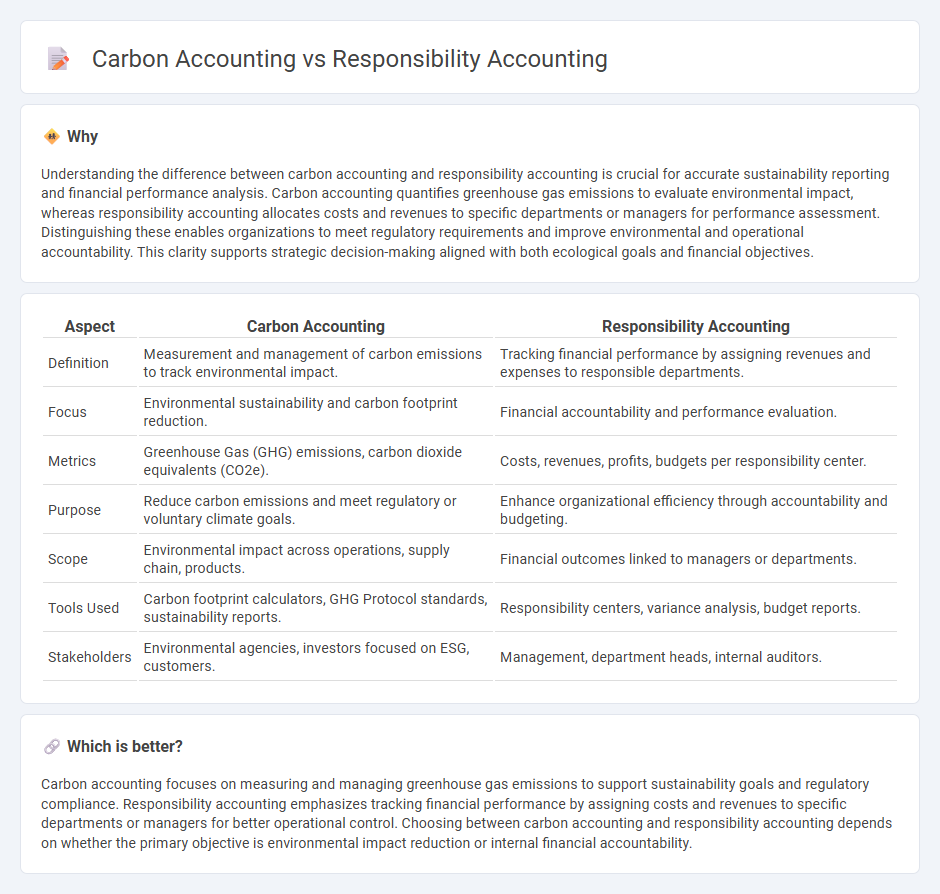
Carbon accounting measures greenhouse gas emissions to evaluate environmental impact, using metrics like carbon footprint and emissions intensity. Responsibility accounting tracks financial performance by assigning costs and revenues to managers based on controllable activities, aiding in precise budget control and accountability. Explore how integrating both methods enhances sustainability and financial transparency.
Why it is important
Understanding the difference between carbon accounting and responsibility accounting is crucial for accurate sustainability reporting and financial performance analysis. Carbon accounting quantifies greenhouse gas emissions to evaluate environmental impact, whereas responsibility accounting allocates costs and revenues to specific departments or managers for performance assessment. Distinguishing these enables organizations to meet regulatory requirements and improve environmental and operational accountability. This clarity supports strategic decision-making aligned with both ecological goals and financial objectives.
Comparison Table
| Aspect | Carbon Accounting | Responsibility Accounting |
|---|---|---|
| Definition | Measurement and management of carbon emissions to track environmental impact. | Tracking financial performance by assigning revenues and expenses to responsible departments. |
| Focus | Environmental sustainability and carbon footprint reduction. | Financial accountability and performance evaluation. |
| Metrics | Greenhouse Gas (GHG) emissions, carbon dioxide equivalents (CO2e). | Costs, revenues, profits, budgets per responsibility center. |
| Purpose | Reduce carbon emissions and meet regulatory or voluntary climate goals. | Enhance organizational efficiency through accountability and budgeting. |
| Scope | Environmental impact across operations, supply chain, products. | Financial outcomes linked to managers or departments. |
| Tools Used | Carbon footprint calculators, GHG Protocol standards, sustainability reports. | Responsibility centers, variance analysis, budget reports. |
| Stakeholders | Environmental agencies, investors focused on ESG, customers. | Management, department heads, internal auditors. |
Which is better?
Carbon accounting focuses on measuring and managing greenhouse gas emissions to support sustainability goals and regulatory compliance. Responsibility accounting emphasizes tracking financial performance by assigning costs and revenues to specific departments or managers for better operational control. Choosing between carbon accounting and responsibility accounting depends on whether the primary objective is environmental impact reduction or internal financial accountability.
Connection
Carbon accounting quantifies greenhouse gas emissions for environmental accountability, directly linking to responsibility accounting, which assigns financial and operational responsibilities within organizations. Responsibility accounting integrates carbon metrics to evaluate department or manager performance in meeting sustainability goals. This connection enhances corporate transparency and drives strategic decision-making toward reducing carbon footprints while maintaining financial accountability.
Key Terms
**Responsibility Accounting:**
Responsibility accounting centers on assigning financial accountability within an organization to specific managers or departments, ensuring each unit controls costs and budgets effectively for improved performance evaluation. This approach facilitates decentralized decision-making by tracking revenues and expenses linked to responsible parties, enhancing operational efficiency and internal control. Discover how responsibility accounting drives organizational success and accountability in financial management.
Cost Centers
Responsibility accounting tracks financial performance by assigning costs to specific cost centers, enhancing accountability and budgeting accuracy within organizations. Carbon accounting, while similarly attributing emissions to specific cost centers, focuses on measuring and managing greenhouse gas emissions to support sustainability goals. Explore how integrating these accounting approaches can optimize both financial control and environmental impact management.
Performance Reports
Responsibility accounting centers on evaluating financial performance by assigning costs and revenues to specific managers or departments, enhancing internal accountability through detailed performance reports. Carbon accounting focuses on measuring and reporting an organization's greenhouse gas emissions, with performance reports highlighting environmental impact and sustainability progress. Explore more to understand how these distinct approaches drive strategic decision-making and reporting frameworks.
 dowidth.com
dowidth.com